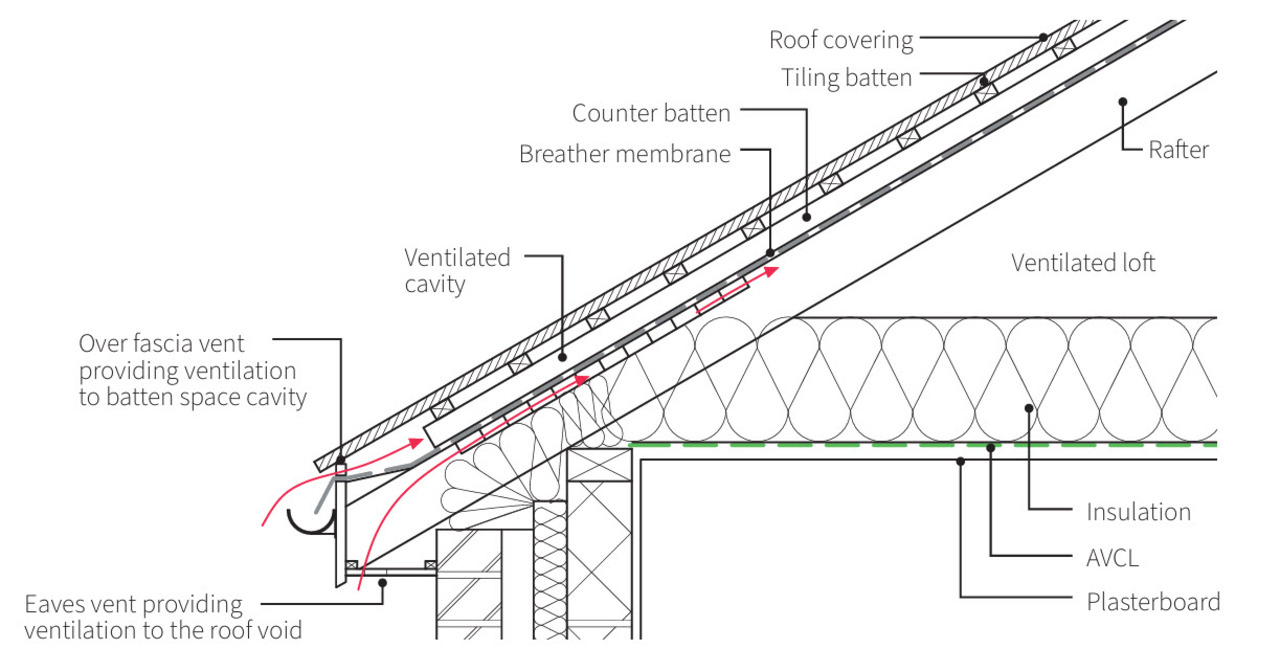
Introduction
What is batten space and why is it required?
Batten space ventilation to cold pitched roofs with LR underlay
Where air impermeable roof coverings are used with an LR (Low-resistance) underlay to a cold pitched roof proposal, there is a risk of moisture accumulation on the underside of the outer weatherproof covering (within the batten space under the tiles). To reduce the risk of potentially damaging condensation, the batten space should be ventilated (see Figure 1). This should be achieved by means of counter battens and vents at both low and high level:
- Low-level vents should be equivalent in free area to a slot 25 mm deep running the whole length of the eaves. Over-fascia vents should provide ventilation into the batten space.
- High-level vents should be equivalent in area to a slot 5 mm deep running the whole length of the ridge in accordance with BS5250.
- Eaves vent should also provide ventilation to the cold roof void as per BS5250.
Note: Alternative methods of ventilating the batten void should provide an equivalent level of ventilation.
Batten space ventilation to cold pitched roofs with LR underlay
Where air impermeable roof coverings are used with an LR underlay to a cold pitched roof proposal there is a risk of moisture accumulation on the underside of the outer weatherproof covering (within the batten space under the tiles). To reduce the risk of potentially damaging condensation, the batten space should be ventilated (see figure 1). This should be achieved by means of counter battens and vents at both low and high level:
- Low-level vents should be equivalent in free area to a slot 25 mm deep running the whole length of the eaves. Over-fascia vents should provide ventilation into the batten space
- High-level vents should be equivalent in area to a slot 5 mm deep running the whole length of the ridge in accordance with BS5250
- Eaves vent should also provide ventilation to the cold roof void as per BS5250
Note: Alternative methods of ventilating the batten void should provide an equivalent level of ventilation.

Batten space ventilation to warm pitched roofs with LR underlay

Batten space ventilation to cold pitched roofs with HR underlay
Batten space ventilation to warm pitched roofs (Insulation along the rafter pitch) with HR underlay
Other considerations
Determining if the underlay is HR or LR
It is very difficult to determine a HR or LR underlay by sight alone and the manufacturer’s third party accreditation should be referred too.
Determining if the roof covering is air impermeable
As can be seen throughout this article, an important factor when determining if the batten space needs ventilation is if the roof covering you’ve chosen is air impermeable.
For discontinuous roof coverings (tiles, slates etc.) written confirmation and evidence must be sought from the manufacturer confirming the tiles/slates are considered air permeable or air impermeable as stipulated in BS 5250:
'The air permeability of an outer weatherproof covering comprising discontinuous units may be determined by testing in accordance with BS 5534:2014+A2:2018, Annex L, using equipment capable of measuring pressure differences of 10 Pa.'
Some tile manufacturers will not have this test information, in such cases we would assume worst case (that the tiles are air impermeable).
What are the warranty provider's concerns surrounding batten space ventilation?
Our stance is batten spaces should be ventilated for warm or cold pitched roofs where an LR (low resistance) underlay is used in combination with an impermeable roof covering.
Failure to provide the correct ventilation is considered to compromise the ability of the pitched roof construction and associated materials in meeting with the Functional Requirements and Performance Standards stipulated by the Technical Manual, notably those relating to durability and protection of materials, and those relating to achieving the required levels of ventilation provided to a pitched roof to adequately control the risk of moisture and condensation.
What developers should action after reading this document
Developers are asked to adopt site specific practices in determining appropriate ventilation strategies for their pitched roofs based upon the factors highlighted within this document and the extensive guidance that can be found within the ‘Roofs’ section of the Technical Manual.
The determining factors for batten space ventilation is if an LR underlay is chosen in combination with an impermeable roof covering. In these situations, batten space ventilation as per the guidance above should be provided.
For warranty purposes we require the following to be provided within design submissions:
· Design details showing the ventilation strategy for the pitched roof to be in accordance with our Technical Manual and BS5250, and;
· Third-party product conformity certificate for any LR underlays used, and;
· Written confirmation and evidence must be sought from the manufacturer confirming the tiles/slates are considered air permeable or air impermeable as stipulated in BS 5250.
Subscribe to be first to hear about our technical updates
Download a PDF version of this article
Disclaimer
This technical document has been prepared by Premier Guarantee exclusively for the benefit of our registered customers. Its sole purpose is to provide guidance on the utilisation and interpretation of technical requirements pertinent to the warranty cover offered by Premier Guarantee.
Please note that this document is not intended for circulation or use beyond the aforementioned purpose. The information presented herein is for general guidance only and does not constitute professional advice. Registered customers and any other party accessing this document are advised not to rely solely on the information contained within.
Nothing in this document is intended to establish, nor should it be construed as creating, any contractual or legal obligations. In the event that any third party chooses to rely on the information provided, they do so entirely at their own risk. Premier Guarantee explicitly disclaims any duty of care or liability that may arise from the use of or reliance on this document by any third party, howsoever arising.
properties.trackTitle
properties.trackSubtitle
